303. Bronze-winged Courser Rhinoptilus chalcopterus (Bronsvlerkdrawwertjie)
Order: Charadriiformes. Family: Glareolidae
Description
Size medium, length about 25 cm; ploverlike, but longer-legged; bold facial pattern of brown and white diagnostic; upperparts and breast dull brown; breastband dark brown; belly white; legs red (pale whitish or yellowish in other coursers); in flight white wingbar, white rump and black tail conspicuous; underwing white. Iris brown; eyering purplish red; bill black, base purplish red; legs and feet dull red.
Juvenile: Faintly mottled rufous above.
Distribution
Occupies much of sub-Saharan Africa, largely excluding the lowland forest of the DRC and west Africa. Within southern Africa it is generally uncommon in northern Namibia, Botswana, Zimbabwe, north-central and southern Mozambique and north-eastern South Africa.
Habitat
It generally prefers Mopane (Colosphermum mopane) woodland with patches of open ground, as well as Okavango woodland and arid savanna.
Movements and migrations
It has a fairly large resident breeding population (breeding from July-December), which is supplemented by an influx of post-breeding migrants originating from the north, staying from November to about May-June.
Diet
Its diet probably consists of mainly insects, although it has hardly been studied. It is nocturnal, often sighted foraging along gravel roads.
Breeding
Likely to be a monogamous solitary nester, probably with a long pair bond. It often lays its eggs on bare ground (such as gravel patches in woodland), although it may also dig a simple scrape in the ground or use a natural depression, sometimes with a rim of twigs and clay. Egg-laying season is from July-December, peaking from October-November. The female lays 2-3, usually two eggs, which are incubated by both sexes for about 25-27 days in shifts of 70-120 minutes. The chicks are well camouflaged for burnt ground (as seen in the photo above) and are defended vigorously by their parents, who often feign injury to distract predators.
Call
Piping ji-ku-it.
Status
Uncommon visitor and resident.
Africa Wild Bird Book
Bronze-winged Courser Photos
303. Bronze-winged Courser Rhinoptilus chalcopterus
 © Flutterby
© Flutterby
Kruger National Park, H3
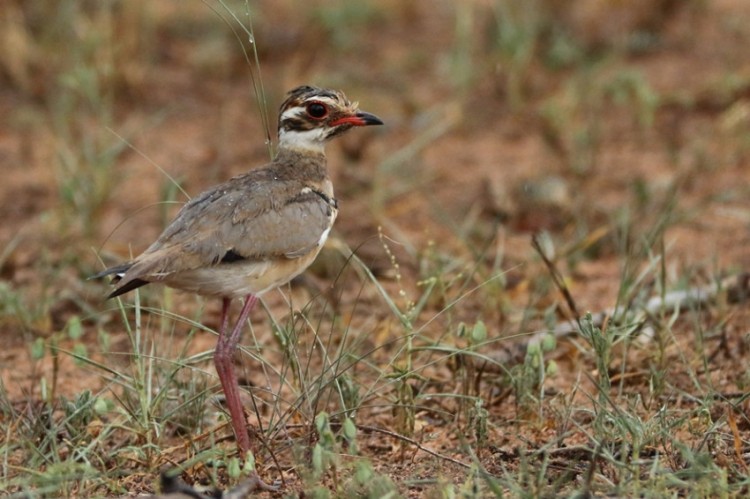 © Dindingwe
© Dindingwe
S36
 © Okie
© Okie
North of Satara KNP
Links:
Sabap2
Species text Sabap1
 © Flutterby
© FlutterbyKruger National Park, H3
S36
North of Satara KNP
Links:
Sabap2
Species text Sabap1
- Lisbeth
- Site Admin
- Posts: 67950
- Joined: Sat May 19, 2012 12:31 pm
- Country: Switzerland
- Location: Lugano
- Contact:
Collared Pratincole
304. Collared Pratincole (Formerly known as Red-winged Pratincole) Glareola pratincola (Rooivlerksprinkaanvoël)
Order: Charadriiformes. Family: Glareolidae
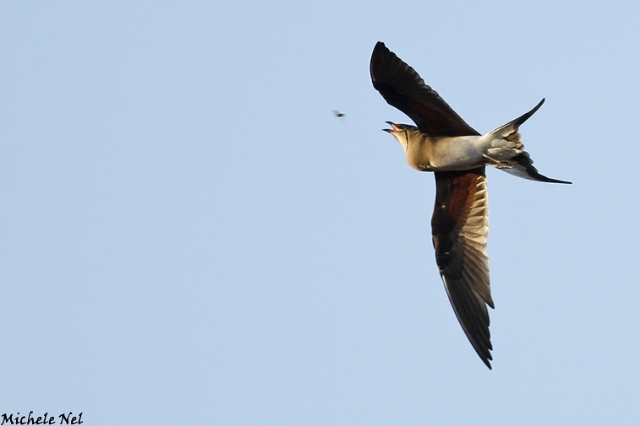 © Michele Nel
© Michele Nel
Busanga Bush Camp, Kafue National Park, Zambia
Description
The common name of this bird arises from the distinctive band of black plumage that runs around the throat, from eye to eye, giving the appearance of a necklace or a collar. The rest of the head, and also the back, are a sandy brown, and the belly and rump are white. The black, forked tail and dark brown wings are long and narrow, and the wings have rust-coloured linings. At rest, wing tips and tail are approximately the same length. The short, decurved bill is black with a red base. Thin black gape-line running from bill back to below eye. Sexes alike.
Adult in breeding plumage has a buffy yellow throat, edged with a thin black line.
In non-breeding plumage, the collar is absent or reduced to a few speckles.
Juveniles lack the distinctive head decorations of the adults, and also differ in the plumage of the back, which has a scaled pattern.
Similar species: Very similar in appearance to the Black-winged Pratincole, but has more red in the beak. The black-winged is more easily distinguished in flight by the entirely black underside of the wing.
Distribution
The Collared Pratincole breeds in southern Europe, north and central Africa, and central Asia, and migrates south during winter to southern Africa and India. In southern Africa it is locally common in northern Botswana, the Caprivi Strip (Namibia), northern Zimbabwe, central and southern Mozambique and eastern South Africa (from Kruger and south along the coast of KZN).

Habitat
Wetland margins and open areas near water.
Movements and migrations
Mainly migratory, staying to breed in southern Africa from about July-February, although along the Zambezi River it is present from April-November.
Diet
It is an insectivore, most active at dawn and dusk, when it feeds predominantly on grasshoppers, crickets, locusts, and beetles.
Breeding
Monogamous and usually loosely colonial. The collared pratincole constructs a nest on a small island in a lake, or on a sandbank or mudflat. The nest itself can be any dent in the earth, even a hoof-print. Hundreds of breeding pairs may nest together. Egg-laying season is from June-December, peaking from October-December. It lays 1-2 eggs, which are incubated by both sexes for about 17-18 days, often wetting their bellies on hot days to cool the eggs.
The chicks leave the nest within about 2-3 days of hatching and are cared for by both parents, fledging at about 25-30 days old. In September, after the breeding season, the European and Asian colonies migrate to the warmer climates of Africa, returning to the breeding areas in March.
Call
Kik-kik in flight. Listen to Bird Call.
Status
Summer visitor.
Order: Charadriiformes. Family: Glareolidae
 © Michele Nel
© Michele NelBusanga Bush Camp, Kafue National Park, Zambia
Description
The common name of this bird arises from the distinctive band of black plumage that runs around the throat, from eye to eye, giving the appearance of a necklace or a collar. The rest of the head, and also the back, are a sandy brown, and the belly and rump are white. The black, forked tail and dark brown wings are long and narrow, and the wings have rust-coloured linings. At rest, wing tips and tail are approximately the same length. The short, decurved bill is black with a red base. Thin black gape-line running from bill back to below eye. Sexes alike.
Adult in breeding plumage has a buffy yellow throat, edged with a thin black line.
In non-breeding plumage, the collar is absent or reduced to a few speckles.
Juveniles lack the distinctive head decorations of the adults, and also differ in the plumage of the back, which has a scaled pattern.
Similar species: Very similar in appearance to the Black-winged Pratincole, but has more red in the beak. The black-winged is more easily distinguished in flight by the entirely black underside of the wing.
Distribution
The Collared Pratincole breeds in southern Europe, north and central Africa, and central Asia, and migrates south during winter to southern Africa and India. In southern Africa it is locally common in northern Botswana, the Caprivi Strip (Namibia), northern Zimbabwe, central and southern Mozambique and eastern South Africa (from Kruger and south along the coast of KZN).

Habitat
Wetland margins and open areas near water.
Movements and migrations
Mainly migratory, staying to breed in southern Africa from about July-February, although along the Zambezi River it is present from April-November.
Diet
It is an insectivore, most active at dawn and dusk, when it feeds predominantly on grasshoppers, crickets, locusts, and beetles.
Breeding
Monogamous and usually loosely colonial. The collared pratincole constructs a nest on a small island in a lake, or on a sandbank or mudflat. The nest itself can be any dent in the earth, even a hoof-print. Hundreds of breeding pairs may nest together. Egg-laying season is from June-December, peaking from October-December. It lays 1-2 eggs, which are incubated by both sexes for about 17-18 days, often wetting their bellies on hot days to cool the eggs.
The chicks leave the nest within about 2-3 days of hatching and are cared for by both parents, fledging at about 25-30 days old. In September, after the breeding season, the European and Asian colonies migrate to the warmer climates of Africa, returning to the breeding areas in March.
Call
Kik-kik in flight. Listen to Bird Call.
Status
Summer visitor.
"Education is the most powerful weapon which you can use to change the world." Nelson Mandela
The desire for equality must never exceed the demands of knowledge
The desire for equality must never exceed the demands of knowledge
- Lisbeth
- Site Admin
- Posts: 67950
- Joined: Sat May 19, 2012 12:31 pm
- Country: Switzerland
- Location: Lugano
- Contact:
Collared Pratincole Photos
304. Collared Pratincole (Formerly known as Red-winged Pratincole) Glareola pratincola (Rooivlerksprinkaanvoël)
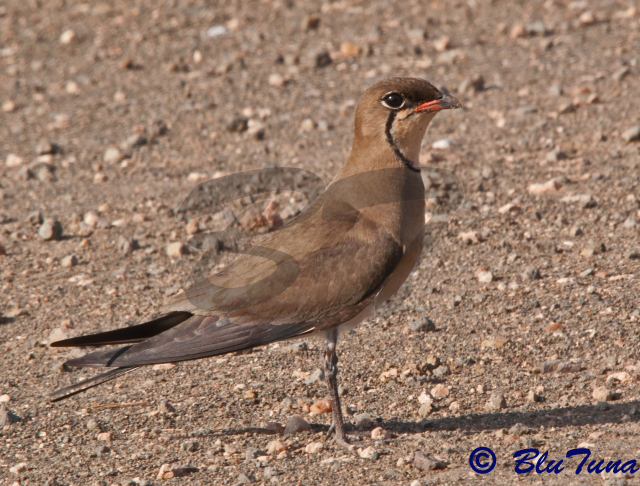 © BluTuna
© BluTuna
Kruger National Park
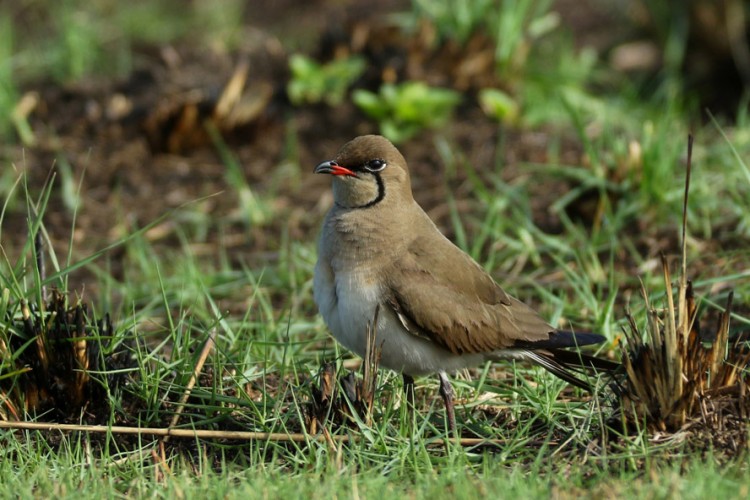 © Dindingwe
© Dindingwe
Near Maputo
Links:
Species text Sabap1
Sabap2: http://sabap2.adu.org.za/species_info.p ... #menu_left
BirdInfo
 © BluTuna
© BluTunaKruger National Park
Near Maputo
Links:
Species text Sabap1
Sabap2: http://sabap2.adu.org.za/species_info.p ... #menu_left
BirdInfo
"Education is the most powerful weapon which you can use to change the world." Nelson Mandela
The desire for equality must never exceed the demands of knowledge
The desire for equality must never exceed the demands of knowledge
- Super Mongoose
- Posts: 808
- Joined: Wed Nov 13, 2013 8:10 am
- Country: South Africa
- Location: Pretoria North
- Contact:
Black-winged Pratincole
305. Black-winged Pratincole Glareola nordmanni (Swartvlerksprinkaanvoël)
Order: Charadriiformes. Family: Glareolidae
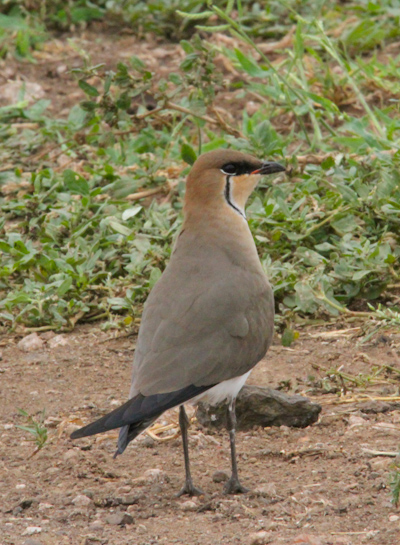 © Super Mongoose
© Super Mongoose
Kruger National Park, Tihongonyeni Waterhole, March 2013
Description
Length 26-27 cm. Brown head and back. Black flight feathers and under wing. Buff chin and throat (bordered in breeding plumage by a thin black line). White belly and rump. Short black bill with red base (reduced in non-breeding season). Black legs. Long forked tail. At rest, wings extend well beyond tail-tip.
Juvenile: Mottled above and below; no black collar on throat.
Similar species: Very similar to Collared Pratincole, distinguishable only at close range; no black line from gape. Darker than Collared Pratincole and lacks the light trailing edge to the inner wings.
Distribution
The Black-winged Pratincole has a large breeding range, from Romania, east through Ukraine to south-west Russia and north Kazakhstan. It migrates to southern Africa, where it spends winter in South Africa (mainly highveld; absent from most of dry W and extreme E and NE; irregularly to SW Cape), Botswana, Namibia and Zimbabwe, and occasionally in West Africa.
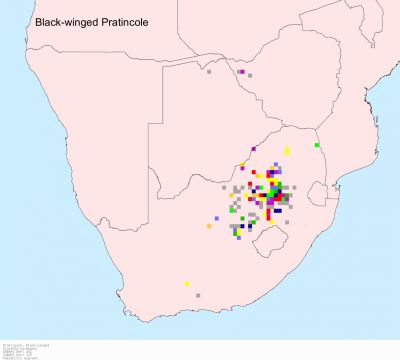
Habitat
Open grassland. It generally prefers open seasonally wet grassland, edges of pans and cultivated land.
Movements and migrations
Leaves its breeding grounds from August-October, moving over land and eventually reaching southern Africa in November, before departing in March.
Diet
It mainly eats insects, doing most of its foraging in the early morning and evening, hawking insects aerially and running in short dashes on the ground to catch prey.
Breeding
In the Black Sea region, the black-winged pratincole breeds from March to July, nesting on open ground in colonies consisting of hundreds of pairs. The nest is a simple scrape, lined with a few dry plant pieces. Clutches of three to four eggs are incubated by both parents and five to six weeks after hatching the chick is independent.
Call
Mellow wi-pi-tip weeup; flocks make low chittering sounds.
Status
Locally abundant non-breedingeeding Palaearctic migrant, October to March; uncommon and sporadic in Zimbabwe on passage, usually in March; numbers declining. Classified as Near Threatened (NT) on the IUCN Red List.
Order: Charadriiformes. Family: Glareolidae
 © Super Mongoose
© Super MongooseKruger National Park, Tihongonyeni Waterhole, March 2013
Description
Length 26-27 cm. Brown head and back. Black flight feathers and under wing. Buff chin and throat (bordered in breeding plumage by a thin black line). White belly and rump. Short black bill with red base (reduced in non-breeding season). Black legs. Long forked tail. At rest, wings extend well beyond tail-tip.
Juvenile: Mottled above and below; no black collar on throat.
Similar species: Very similar to Collared Pratincole, distinguishable only at close range; no black line from gape. Darker than Collared Pratincole and lacks the light trailing edge to the inner wings.
Distribution
The Black-winged Pratincole has a large breeding range, from Romania, east through Ukraine to south-west Russia and north Kazakhstan. It migrates to southern Africa, where it spends winter in South Africa (mainly highveld; absent from most of dry W and extreme E and NE; irregularly to SW Cape), Botswana, Namibia and Zimbabwe, and occasionally in West Africa.

Habitat
Open grassland. It generally prefers open seasonally wet grassland, edges of pans and cultivated land.
Movements and migrations
Leaves its breeding grounds from August-October, moving over land and eventually reaching southern Africa in November, before departing in March.
Diet
It mainly eats insects, doing most of its foraging in the early morning and evening, hawking insects aerially and running in short dashes on the ground to catch prey.
Breeding
In the Black Sea region, the black-winged pratincole breeds from March to July, nesting on open ground in colonies consisting of hundreds of pairs. The nest is a simple scrape, lined with a few dry plant pieces. Clutches of three to four eggs are incubated by both parents and five to six weeks after hatching the chick is independent.
Call
Mellow wi-pi-tip weeup; flocks make low chittering sounds.
Status
Locally abundant non-breedingeeding Palaearctic migrant, October to March; uncommon and sporadic in Zimbabwe on passage, usually in March; numbers declining. Classified as Near Threatened (NT) on the IUCN Red List.
Imagine RhiNOs!
We have to stand together to STOP the madness!
Please support a Rhino project!
We have to stand together to STOP the madness!
Please support a Rhino project!
Black-winged Pratincole Photos
305. Black-winged Pratincole Glareola nordmanni
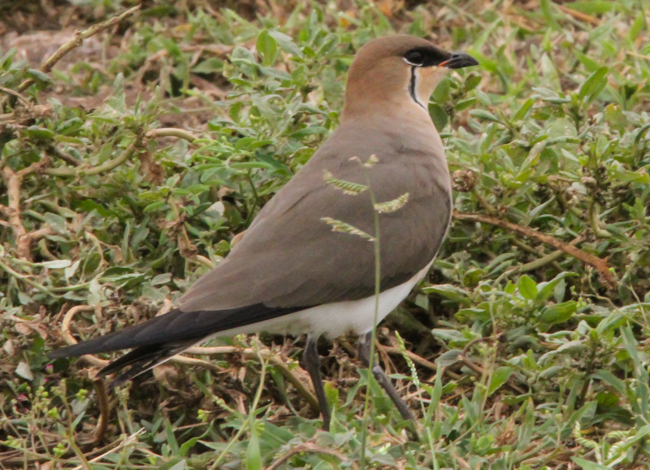 © Super Mongoose
© Super Mongoose
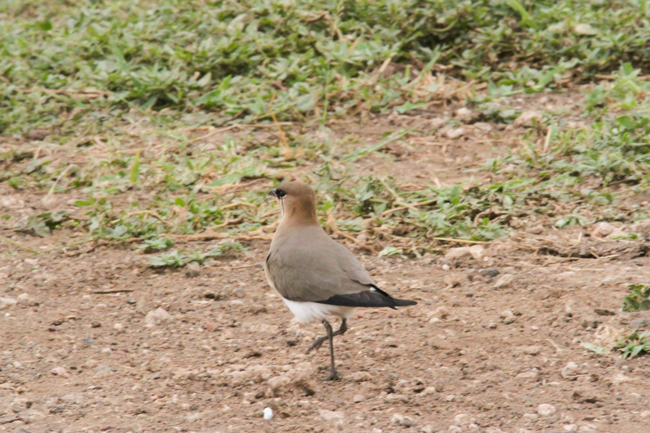 © Super Mongoose
© Super Mongoose
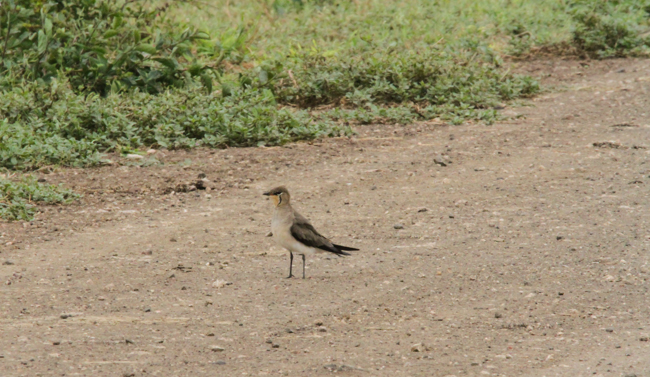 © Super Mongoose
© Super Mongoose
Kruger National Park, Tihongonyeni Waterhole, March 2013
Links:
Sabap2: http://sabap2.adu.org.za/species_info.p ... #menu_left
BirdInfo
Sasol
 © Super Mongoose
© Super Mongoose © Super Mongoose
© Super Mongoose © Super Mongoose
© Super MongooseKruger National Park, Tihongonyeni Waterhole, March 2013
Links:
Sabap2: http://sabap2.adu.org.za/species_info.p ... #menu_left
BirdInfo
Sasol
- Super Mongoose
- Posts: 808
- Joined: Wed Nov 13, 2013 8:10 am
- Country: South Africa
- Location: Pretoria North
- Contact:
ORDER CHARADRIIFORMES Family Laridae (Gulls, Terns and Skimmers)
Laridae is family of birds (of the order Charadriiformes) that comprises skuas, jaegers, gulls, terns, skimmers, noddies.
Some classification systems place only the gulls in the family Laridae and regognize the larid group as the suborder Lari as part of the order Charadriiformes which includes the gulls, terns, skuas and skimmers, with the waders and snipes making up the rest of the order.
The larids are generally larger species which take fish from the sea. Several gulls and skuas will also take food items from beaches, or rob smaller species, and some have become adapted to inland environments.
There are roughly 100 bird species in this family depending on how different species are split or lumped. They have a worldwide distribution from the high Arctic tundra to Antarctica and are found on every continent, but are missing from the heaviest tropical jungles of Africa and South America as well as the driest, most barren deserts in Africa and Australia. Though often associated with beaches and coasts, Laridae birds are also frequent residents of wetlands, marshes, rural areas and even urban and suburban regions including heavily populated areas and landfills.
These birds share a number of physical characteristics that identify them as members of the Laridae family, including:
Omnivorous diets, including trash and carrion
Thick bill that is relatively long, though shapes vary greatly
Often countershaded plumage with white underparts
Long, narrow wings with a tapered shape for soaring flight
Social behavior and gregarious tendencies
Webbed feet for swimming, though they are more often seen on land or in flight.
Some classification systems place only the gulls in the family Laridae and regognize the larid group as the suborder Lari as part of the order Charadriiformes which includes the gulls, terns, skuas and skimmers, with the waders and snipes making up the rest of the order.
The larids are generally larger species which take fish from the sea. Several gulls and skuas will also take food items from beaches, or rob smaller species, and some have become adapted to inland environments.
There are roughly 100 bird species in this family depending on how different species are split or lumped. They have a worldwide distribution from the high Arctic tundra to Antarctica and are found on every continent, but are missing from the heaviest tropical jungles of Africa and South America as well as the driest, most barren deserts in Africa and Australia. Though often associated with beaches and coasts, Laridae birds are also frequent residents of wetlands, marshes, rural areas and even urban and suburban regions including heavily populated areas and landfills.
These birds share a number of physical characteristics that identify them as members of the Laridae family, including:
Omnivorous diets, including trash and carrion
Thick bill that is relatively long, though shapes vary greatly
Often countershaded plumage with white underparts
Long, narrow wings with a tapered shape for soaring flight
Social behavior and gregarious tendencies
Webbed feet for swimming, though they are more often seen on land or in flight.
Imagine RhiNOs!
We have to stand together to STOP the madness!
Please support a Rhino project!
We have to stand together to STOP the madness!
Please support a Rhino project!
Family Laridae (Gulls, Terns and Skimmers) Index
Species indigenous to southern Africa:
Family Laridae (Gulls, Terns and Skimmers)
Anous stolidus Brown Noddy 340
Anous tenuirostris Lesser Noddy 341
Gygis alba White Tern
Rynchops flavirostris African Skimmer 343
Rissa tridactyla Black-legged Kittiwake 320
Xema sabini Sabine's Gull 318
Chroicocephalus genei Slender-billed Gull
Chroicocephalus ridibundus Black-headed Gull 319
Chroicocephalus cirrocephalus Grey-headed Gull 315
Chroicocephalus hartlaubii Hartlaub's Gull 316
Leucophaeus pipixcan Franklin's Gull 317
Ichthyaetus leucophthalmus White-eyed Gull
Larus delawarensis Ring-billed Gull
Larus dominicanus Kelp Gull 312
Larus cachinnans Caspian Gull
Larus fuscus Lesser Black-backed Gull (Includes Heuglin‘s Gull L. heuglini as subspecies) 313
Gelochelidon nilotica Gull-billed Tern 321
Hydroprogne caspia Caspian Tern 322
Thalasseus maximus Royal Tern 323
Thalasseus bergii Greater Crested Tern, Swift Tern 324
Thalasseus bengalensis Lesser Crested Tern 325
Thalasseus sandvicensis Sandwich Tern 326
Sternula albifrons Little Tern 335
Sternula balaenarum Damara Tern 334
Onychoprion anaethetus Bridled Tern 333
Onychoprion fuscatus Sooty Tern 332
Sterna dougallii Roseate Tern 330
Sterna sumatrana Black-naped Tern 331
Sterna hirundo Common Tern 327
Sterna repressa White-cheeked Tern 336
Sterna paradisaea Arctic Tern 328
Sterna vittata Antarctic Tern 329
Chlidonias hybrida Whiskered Tern 338
Chlidonias leucopterus White-winged Tern 339
Chlidonias niger Black Tern 337
Family Laridae (Gulls, Terns and Skimmers)
Anous stolidus Brown Noddy 340
Anous tenuirostris Lesser Noddy 341
Gygis alba White Tern
Rynchops flavirostris African Skimmer 343
Rissa tridactyla Black-legged Kittiwake 320
Xema sabini Sabine's Gull 318
Chroicocephalus genei Slender-billed Gull
Chroicocephalus ridibundus Black-headed Gull 319
Chroicocephalus cirrocephalus Grey-headed Gull 315
Chroicocephalus hartlaubii Hartlaub's Gull 316
Leucophaeus pipixcan Franklin's Gull 317
Ichthyaetus leucophthalmus White-eyed Gull
Larus delawarensis Ring-billed Gull
Larus dominicanus Kelp Gull 312
Larus cachinnans Caspian Gull
Larus fuscus Lesser Black-backed Gull (Includes Heuglin‘s Gull L. heuglini as subspecies) 313
Gelochelidon nilotica Gull-billed Tern 321
Hydroprogne caspia Caspian Tern 322
Thalasseus maximus Royal Tern 323
Thalasseus bergii Greater Crested Tern, Swift Tern 324
Thalasseus bengalensis Lesser Crested Tern 325
Thalasseus sandvicensis Sandwich Tern 326
Sternula albifrons Little Tern 335
Sternula balaenarum Damara Tern 334
Onychoprion anaethetus Bridled Tern 333
Onychoprion fuscatus Sooty Tern 332
Sterna dougallii Roseate Tern 330
Sterna sumatrana Black-naped Tern 331
Sterna hirundo Common Tern 327
Sterna repressa White-cheeked Tern 336
Sterna paradisaea Arctic Tern 328
Sterna vittata Antarctic Tern 329
Chlidonias hybrida Whiskered Tern 338
Chlidonias leucopterus White-winged Tern 339
Chlidonias niger Black Tern 337
African Skimmer
343. African Skimmer Rynchops flavirostris (Waterploeër)
Order: Charadriiformes. Family: Laridae
Description
38 cm. Ternlike. They have very long wings. The back, hindneck, and crown are black. The forehead and rest of the body is white, with a bright, long, orange beak that ends with a yellow tip, lower jaw much longer than upper. Their short forked tail is white, and their legs are bright red. Very long scimitar-shaped wings. Black upperwings. Bright red legs. Their bill structure is unique. The lower mandible is much longer than the upper mandible, and flattened sideways like scissor blades.
Juvenile: streaked forehead, buff-edges geathers on upperparts, blackish bill with red base.
Distribution
Occurs across much of sub-Saharan Africa, absent from arid and semi-arid areas. In southern Africa it is locally common in the Caprivi Strip (Namibia), northern Botswana, northern Zimbabwe and central Mozambique. It is found mainly along the Zambezi, Chobe and Okavango rivers, the Okavango Delta and dams in the Hwange National Park.

Habitat
Broad rivers, coastal lagoons, open marshes and lakes, resting and breeding on large, dry sandbars and beaches.
Movements
It is an intra-African migrant, arriving late April–May in Zimbabwe, the timing being dependent on the availability of suitable exposed sandbars. Arrival in the Okavango Panhandle is in June. Departure is dependent on the intensity of the early rains and concomitant flooding of sandbanks, and takes place late November–January or even early February with some birds remaining through the rains, particularly in drought years.
Diet
It almost exclusively eats small riverine fish, mainly hunting at night as it has powerful nocturnal vision, although when feeding chicks it often has to forage in the afternoon as well. It mainly forages using a unique technique in which it flies low, with its oversized lower mandible slicing through the water; if it touches something (such as a fish) the bird instinctively shuts its bill to the capture the prey.
Breeding
Monogamous, nesting on expansive sandbanks either solitarily or in a loose colony of up to 25 pairs, sometimes along with other birds such as Collared Pratincoles, Pied Avocets and White-fronted Plovers. The nest is probably built by both sexes, consisting of a deep scrape in the ground (which is often damp), usually digging multiple scrapes before selecting one. It is typically placed close to the water level on a riverine sandbar. Egg-laying season is mainly from August-October. It lays 2-4 eggs, which are incubated by both sexes (primarily by the female) for about 20-22 days. The buffy-white chicks leave the nest within 1-2 days of hatching, led to the water by the parents, who shade them in the heat of the day and regularly feed them. They eventually take their first flight at about 5-6 weeks old, after which they are still fed by both adults for some time. The adults are vigilant in the defence of their young, mobbing predators and sometimes carrying their young to safety in their bill.
The colonies of eggs are vulnerable to being trampled by hippopotami and elephants and to raising river water levels which could destroy an entire colony.
Call
Loud sharp kik-kik-kik. Listen to Bird Call.
Status
Fairly common localised resident. Classified as Near Threatened (NT) on the IUCN Red List.
Order: Charadriiformes. Family: Laridae
Description
38 cm. Ternlike. They have very long wings. The back, hindneck, and crown are black. The forehead and rest of the body is white, with a bright, long, orange beak that ends with a yellow tip, lower jaw much longer than upper. Their short forked tail is white, and their legs are bright red. Very long scimitar-shaped wings. Black upperwings. Bright red legs. Their bill structure is unique. The lower mandible is much longer than the upper mandible, and flattened sideways like scissor blades.
Juvenile: streaked forehead, buff-edges geathers on upperparts, blackish bill with red base.
Distribution
Occurs across much of sub-Saharan Africa, absent from arid and semi-arid areas. In southern Africa it is locally common in the Caprivi Strip (Namibia), northern Botswana, northern Zimbabwe and central Mozambique. It is found mainly along the Zambezi, Chobe and Okavango rivers, the Okavango Delta and dams in the Hwange National Park.

Habitat
Broad rivers, coastal lagoons, open marshes and lakes, resting and breeding on large, dry sandbars and beaches.
Movements
It is an intra-African migrant, arriving late April–May in Zimbabwe, the timing being dependent on the availability of suitable exposed sandbars. Arrival in the Okavango Panhandle is in June. Departure is dependent on the intensity of the early rains and concomitant flooding of sandbanks, and takes place late November–January or even early February with some birds remaining through the rains, particularly in drought years.
Diet
It almost exclusively eats small riverine fish, mainly hunting at night as it has powerful nocturnal vision, although when feeding chicks it often has to forage in the afternoon as well. It mainly forages using a unique technique in which it flies low, with its oversized lower mandible slicing through the water; if it touches something (such as a fish) the bird instinctively shuts its bill to the capture the prey.
Breeding
Monogamous, nesting on expansive sandbanks either solitarily or in a loose colony of up to 25 pairs, sometimes along with other birds such as Collared Pratincoles, Pied Avocets and White-fronted Plovers. The nest is probably built by both sexes, consisting of a deep scrape in the ground (which is often damp), usually digging multiple scrapes before selecting one. It is typically placed close to the water level on a riverine sandbar. Egg-laying season is mainly from August-October. It lays 2-4 eggs, which are incubated by both sexes (primarily by the female) for about 20-22 days. The buffy-white chicks leave the nest within 1-2 days of hatching, led to the water by the parents, who shade them in the heat of the day and regularly feed them. They eventually take their first flight at about 5-6 weeks old, after which they are still fed by both adults for some time. The adults are vigilant in the defence of their young, mobbing predators and sometimes carrying their young to safety in their bill.
The colonies of eggs are vulnerable to being trampled by hippopotami and elephants and to raising river water levels which could destroy an entire colony.
Call
Loud sharp kik-kik-kik. Listen to Bird Call.
Status
Fairly common localised resident. Classified as Near Threatened (NT) on the IUCN Red List.
African Skimmer Photos
343. African Skimmer Rynchops flavirostris
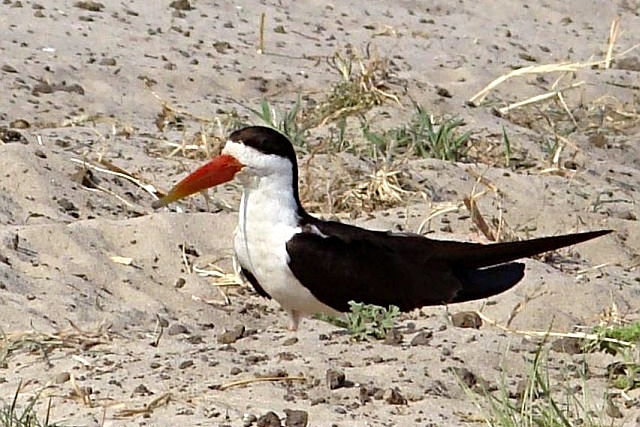 © Toko
© Toko
Botswana
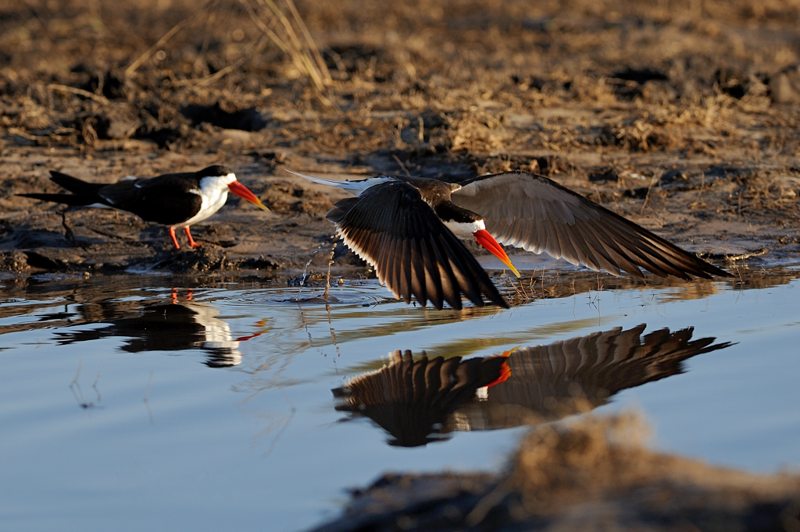 © Dewi
© Dewi
Botswana
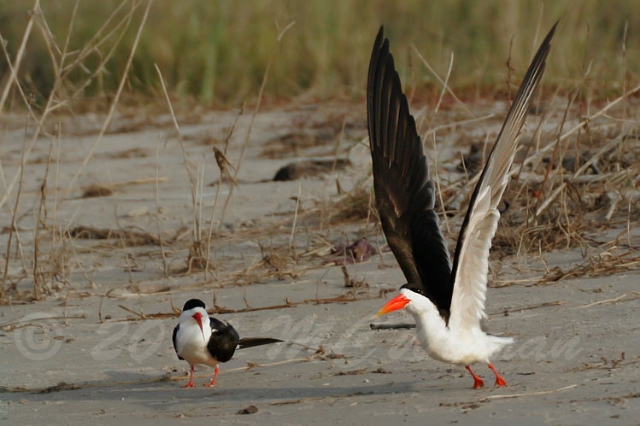 © Moshi Monster
© Moshi Monster
Botswana
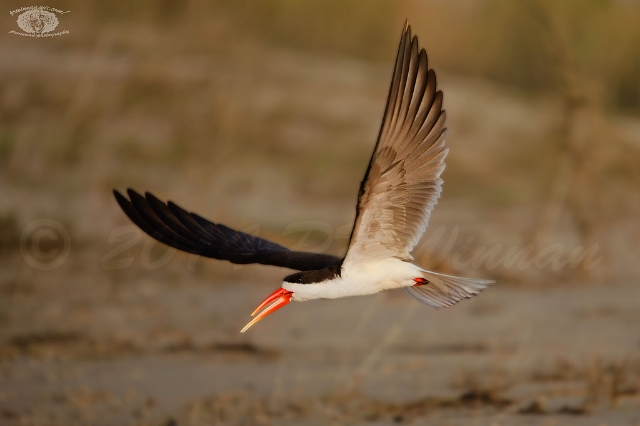 © PRWIN
© PRWIN
Botswana
Links:
Sabap2
ARKive: http://www.arkive.org/african-skimmer/r ... virostris/
Skimmers, in: Trevor Carnaby. Beat about the Bush: Birds
 © Toko
© TokoBotswana
 © Dewi
© DewiBotswana
 © Moshi Monster
© Moshi MonsterBotswana
 © PRWIN
© PRWINBotswana
Links:
Sabap2
ARKive: http://www.arkive.org/african-skimmer/r ... virostris/
Skimmers, in: Trevor Carnaby. Beat about the Bush: Birds


